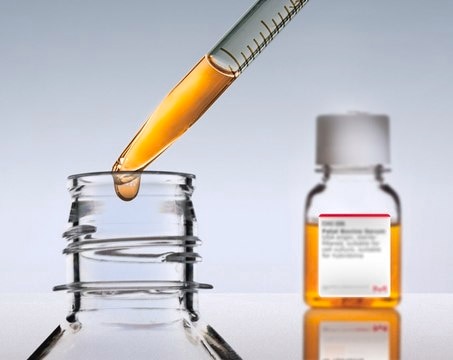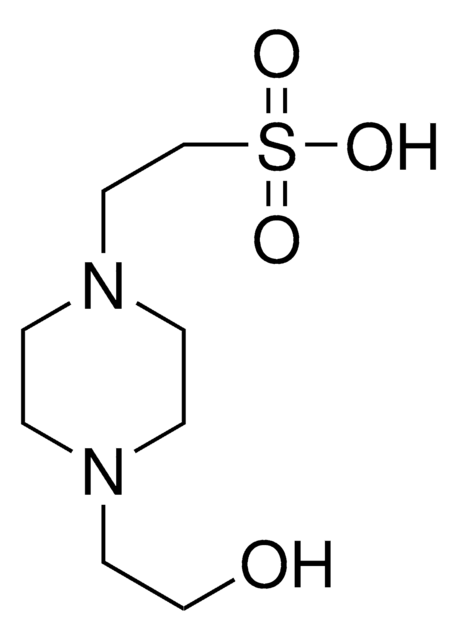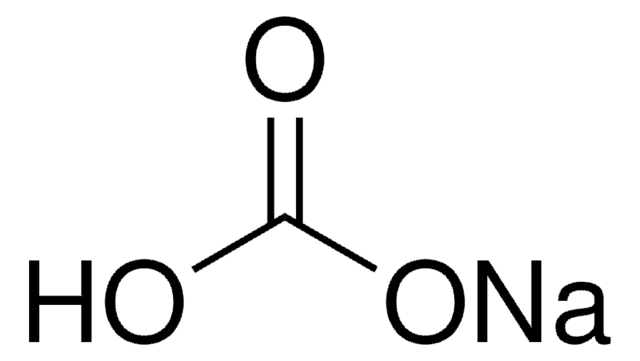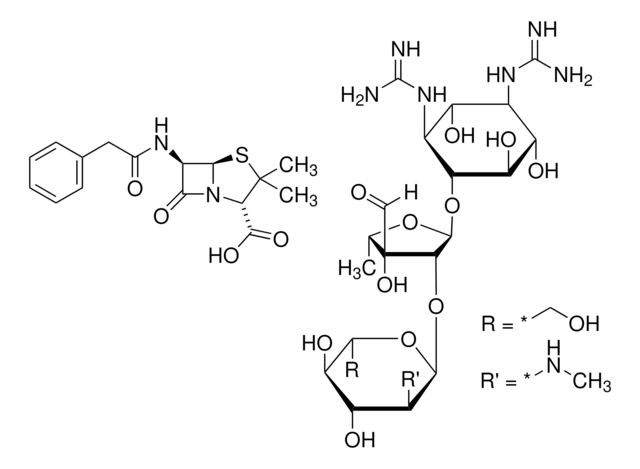H4034
HEPES
BioPerformance Certified, ≥99.5% (titration), suitable for cell culture
Synonym(s):
4-(2-Hydroxyethyl)piperazine-1-ethanesulfonic acid, N-(2-Hydroxyethyl)piperazine-N′-(2-ethanesulfonic acid)
About This Item
Recommended Products
grade
BioPerformance Certified
Quality Level
assay
≥99.5% (titration)
form
crystalline powder
storage condition
dry at room temperature
technique(s)
cell culture | mammalian: suitable
competitive inhibition ELISA: suitable
impurities
endotoxin and total aerobic microbial count, tested
color
white
useful pH range
6.8-8.2
pKa (25 °C)
7.5
cation traces
Fe: ≤5 ppm
absorption
≤0.05 at 260 in H2O at 0.1 M
≤0.05 at 280 in H2O at 0.1 M
suitability
suitable for Western blot
suitable for component for culture media
application(s)
clinical research
diagnostic assay manufacturing
general analytical
life science and biopharma
foreign activity
DNase, RNase, NICKase, protease, none detected
SMILES string
OCCN1CCN(CC1)CCS(O)(=O)=O
InChI
1S/C8H18N2O4S/c11-7-5-9-1-3-10(4-2-9)6-8-15(12,13)14/h11H,1-8H2,(H,12,13,14)
InChI key
JKMHFZQWWAIEOD-UHFFFAOYSA-N
Looking for similar products? Visit Product Comparison Guide
Related Categories
General description
HEPES also proves advantageous in various biological and biochemical processes. Its ampholytic nature makes it suitable as a separator for creating pH gradients in isoelectric focusing, a technique often employed in protein separation and analysis. Moreover, HEPES exhibits minimal interference with DNA-restriction enzyme reactions compared to buffers with fewer substituted amine groups, such as Tris. This makes it a preferred choice for applications involving DNA manipulation and analysis. Beyond these specific applications, HEPES is valuable in numerous other biological and biochemical processes, including immunoprecipitation, cell lysis, and live cell imaging. Its versatility, coupled with exceptional pH buffering capacity and minimal interaction with other molecules, establishes HEPES as an indispensable tool across diverse research domains.
Application
- To supplement Dulbecco′s modified Eagle′s medium to culture and maintain cell lines
- As a component of platelet suspension buffer
- To supplement Hank′s basic salt solution, which is used to wash pancreatic tissue
- As a component of wash buffer and blocking buffer in the purification and quantification of protein with enzyme-linked immunosorbent (ELISA) assay
- For the adjustment and maintenance of pH of biological solutions
- As a component of Hank′s balanced salt solution (HBSS) and dissociation medium to study neuronal development
- For homogenization of tissue and in the preparation of cytosolic and nuclear extract from cells
- As a component of keratinocyte and fibroblast culture medium
Features and Benefits
- Tested to confirm low levels of heavy metal contamination, ensuring suitability for various applications
- Highly soluble in water with a useful pH range of 6.8 - 8.2 and pKa of 7.5 at 25 °C
- Negligible metal ion binding
- Less toxic to cells than other buffers such as Tris and phosphate
- Stable in a wide pH range
- Tested for Endotoxins and Total Aerobic Microbial Count
- Free from DNase, NICKase, RNase, Endonuclease, Exonuclease and Protease
Other Notes
also commonly purchased with this product
comparable product
Storage Class
11 - Combustible Solids
wgk_germany
WGK 1
flash_point_f
Not applicable
flash_point_c
Not applicable
ppe
Eyeshields, Gloves, type N95 (US)
Certificates of Analysis (COA)
Search for Certificates of Analysis (COA) by entering the products Lot/Batch Number. Lot and Batch Numbers can be found on a product’s label following the words ‘Lot’ or ‘Batch’.
Already Own This Product?
Find documentation for the products that you have recently purchased in the Document Library.
Customers Also Viewed
Protocols
cAMP measurements are obtained using an ELISA assay (Harlow and Lane 1988). Commercial radio-immunoassays, or ELISA kits, to assay cAMP can be purchased from various manufacturers.
To determine the molecular weights of protein antigens, to study protein/protein interactions, to determine specific enzymatic activity, to monitor protein post-translational modifications and to determine the presence and quantity of proteins.
Our team of scientists has experience in all areas of research including Life Science, Material Science, Chemical Synthesis, Chromatography, Analytical and many others.
Contact Technical Service



